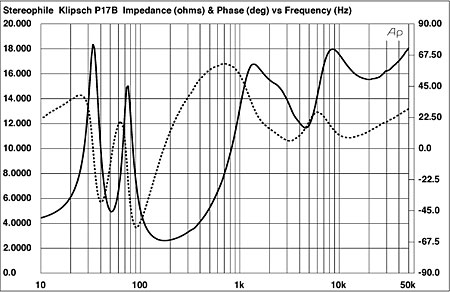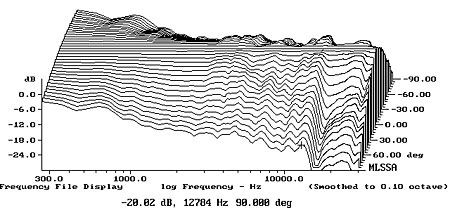| Columns Retired Columns & Blogs |
Klipsch Palladium P-17B loudspeaker Measurements
Sidebar 3: Measurements
My estimate of the Palladium P-17B's voltage sensitivity was a little lower than the specified 94dB/2.83V/m, at 90.7dB(B). However, this is still significantly higher than average; the P-17B will work well with relatively low-powered amplifiers. Its impedance (fig.1) varies widely: averaging 14 ohms above 1kHz, it drops below 3 ohms between 128 and 265Hz, with a minimum value of 2.6 ohms at 170Hz. There is also an amplifier-frightening combination of 4.5 ohms and –50° electrical phase at 104Hz, a frequency where music has high energy levels. So while the Klipsch will play loud with a low-powered amplifier, that amplifier will still need to be able to deliver goodly amounts of current. The shape of the impedance trace suggests that with amplifiers having a high source impedance, such as classic tube designs, the midrange and bass responses will be a little shelved down, emphasizing the speaker's treble. While the shape of the P-17B's impedance trace is very similar above 1kHz to that of the larger, floorstanding P-39F, which Wes Phillips reviewed in June 2009 (see fig.1 in its measurements), its average value in the treble is higher. As the horn arrays appear physically identical, this suggests that the P-17B's midrange and tweeter are potted down with series resistors to better match the lower sensitivity of the single woofer than are the P-39F's three drive-units.

Fig.1 Klipsch Palladium P-17B, electrical impedance (solid) and phase (dashed). (2 ohms/vertical div.)
Though it's probably not visible at the scale fig.1 is printed in the magazine, a very slight wrinkle in the traces around 340Hz implies the existence of some kind of resonance at that frequency. Exploring the enclosure panels' vibrational behavior with a plastic-tape accelerometer, I did find a fairly strong, high-Q mode on all surfaces at 336Hz (fig.2), with another mode on the top panel at 460Hz. However, Erick Lichte didn't note any congestion or coloration in this frequency region, so I must assume that these cabinet resonances look worse than they sound.

Fig.2 Klipsch Palladium P-17B, cumulative spectral-decay plot calculated from output of accelerometer fastened to center of side panel (MLS driving voltage to speaker, 7.55V; measurement bandwidth, 2kHz).
The saddle centered on 52Hz in the impedance-magnitude trace suggests that this is the tuning frequency of the large, flared port on the P-17B's rear. Looking at the response of the woofer, measured in the nearfield (fig.3, blue trace), the expected minimum-motion notch does indeed occur at that frequency, and the port's output (red) peaks in the appropriate manner between 40 and 70Hz. The port rolls out smoothly, but two resonant modes are visible in its midrange output. While I could just hear these modes from behind the speaker when it was playing pink noise, the fact that the port faces away from the listener will further reduce their audibility. The woofer appears to cross over to the horn array (green trace) at 560Hz, though its rollout is interrupted by a shelf between 1 and 2kHz. The horn array looks as if it is a couple of dB too high in level compared with the woofer but it offers a basically flat response within its passband, with a couple of moderate, narrow peaks apparent at 10 and 17kHz. It rolls out below the crossover frequency with an 18dB/octave slope.

Fig.3 Klipsch Palladium P-17B, acoustic crossover on tweeter axis at 50", corrected for microphone response, with nearfield responses of woofer (blue) and port (red) plotted below 350Hz and 1kHz, respectively.
Fig.4 shows how these individual outputs sum on the tweeter axis in the farfield. Again, the region covered by the horn array is impressively even, other than a slight discontinuity between 4 and 6kHz, and the two moderate peaks in the top octave mentioned earlier. Props to EL for identifying this aspect of the Klipsch's balance, but I doubt that these peaks in themselves would have led to his finding the P-17B's treble to sound "a bit too airy" without the skewing of the tonal balance by the impedance characteristic mentioned above. At the other end of the spectrum, while a broad boost is visible in the upper bass, this is primarily a result of the nearfield measurement technique. The lows are balanced a little on the lean side, rolling off below 45Hz, as EL noted.

Fig.4 Klipsch Palladium P-17B, anechoic response on tweeter axis at 50", averaged across 30° horizontal window and corrected for microphone response, with complex sum of nearfield responses plotted below 300Hz.
As with the P-39F, the P-17B's lateral dispersion is superbly even and controlled up to 12.7kHz, where the horn-loaded tweeter suddenly becomes more directional (fig.5). In fact, if you look at fig.5 in the P-39 review, you can see that the P-17B's dispersion is even better controlled than that of its more expensive sibling. This kind of behavior generally correlates with well-defined stereo imaging, and I note that EL did get well-defined, stable lateral imaging. However, it must remain a mystery why EL couldn't get the soundstaging depth from the Klipsches that he experienced with the Revel Ultima Gems. Could this have been a residual effect of the cabinet resonances, which tend to "pull" the imaging toward the speaker positions in the frequency bands affected, which I conjecture might have been the case with the Totem Forests he wrote about in the January issue? Or was it due to something else, such as the speaker's lack of time coherence (see later)?

Fig.5 Klipsch Palladium P-17B, lateral response family at 50", normalized to response on tweeter axis, from back to front: differences in response 90–5° off axis, reference response, differences in response 5–90° off axis.
In the vertical plane (fig.6), a sharply defined suckout develops at 3.7kHz for axes above the tweeter's, suggesting that this is the crossover frequency between the midrange and treble horns. As EL noted, the P-17B is a touch fussy about listening axis; fig.6 reveals that, as long as you sit with your ears between the tweeter axis and the midrange axis, all will be well. If you use stands low enough that you can see the tops of the speaker enclosures, you'll be sitting too high.

Fig.6 Klipsch Palladium P-17B, vertical response family at 50", normalized to response on tweeter axis, from back to front: differences in response 45–5° above axis, reference response, differences in response 5–45° below axis.
The use of horn loading for the upper-frequency drivers moves their radiating centers significantly behind the plane of the front baffle, which gives a step response (fig.7) in which the individual drive-unit outputs can be clearly distinguished by their different arrival times at the microphone. The tweeter's output arrives first, and, as suggested by the sharply defined negative-going spike, the tweeter is connected in inverted acoustic polarity. It is followed soon after by the output of the midrange unit, also in inverted polarity, and finally by the woofer's output, which arrives a little later, at the 4.4 millisecond mark. Each unit's step smoothly blends with that of the next lower in frequency, correlating with the good frequency-domain integration seen in fig.4, though the very slight discontinuities in the blend between the tweeter and midrange steps suggest that the optimal listening axis is a little below the tweeter, as EL found in his listening.

Fig.7 Klipsch Palladium P-17B, step response on tweeter axis at 50" (5ms time window, 30kHz bandwidth).
Finally, the P-17B's cumulative spectral-decay plot (fig.8) is superbly clean in the region covered by the tweeter, and almost as good in the midrange. It's not surprising that EL felt this horn-loaded tweeter could be mistaken for a good ribbon unit.

Fig.8 Klipsch Palladium P-17B, cumulative spectral-decay plot on tweeter axis at 50" (0.15ms risetime).
Not only is Klipsch's Palladium P-17B a beautiful-looking speaker, it seems equally well engineered, and a genuinely 21st-century horn design.—John Atkinson
- Log in or register to post comments




































